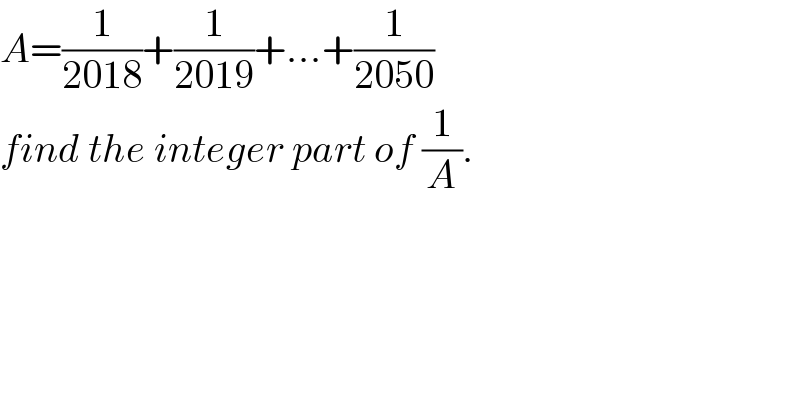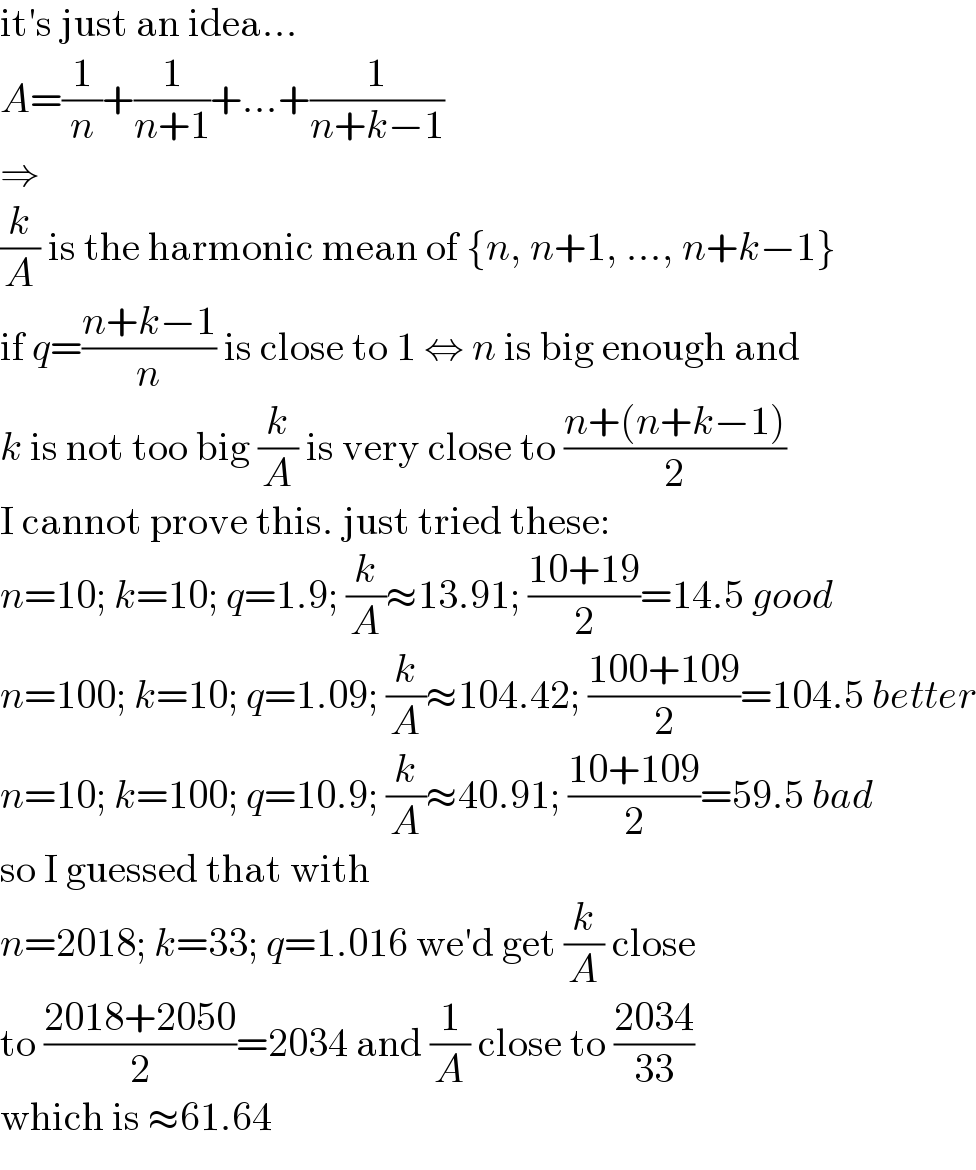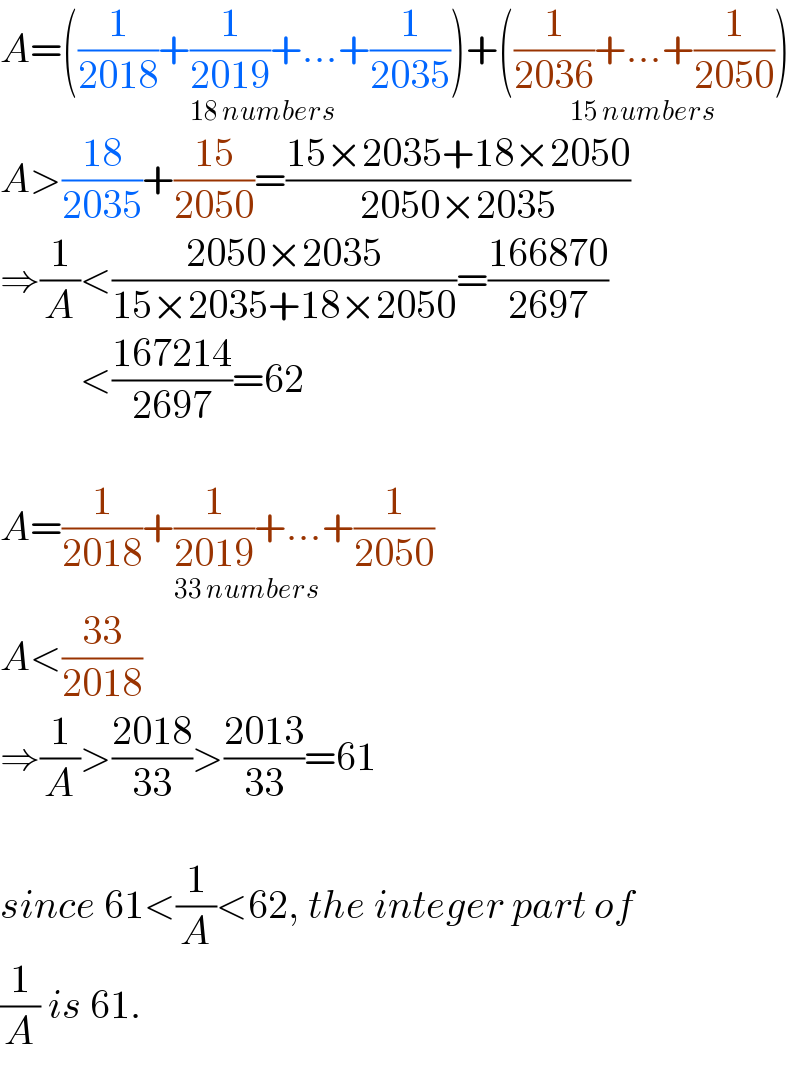
Question Number 178777 by mr W last updated on 21/Oct/22

$${A}=\frac{\mathrm{1}}{\mathrm{2018}}+\frac{\mathrm{1}}{\mathrm{2019}}+...+\frac{\mathrm{1}}{\mathrm{2050}} \\ $$$${find}\:{the}\:{integer}\:{part}\:{of}\:\frac{\mathrm{1}}{{A}}. \\ $$
Commented by Frix last updated on 21/Oct/22

$$\frac{\mathrm{1}}{{A}}\:\mathrm{should}\:\mathrm{be}\:\mathrm{close}\:\mathrm{to}\:\frac{\mathrm{2018}+\mathrm{2050}}{\mathrm{2}×\mathrm{33}}=\mathrm{61}.\mathrm{6363}... \\ $$$$\Rightarrow\:\mathrm{answer}\:\mathrm{should}\:\mathrm{be}\:\mathrm{61} \\ $$
Commented by mr W last updated on 21/Oct/22

$${how}\:{is}\:\frac{\mathrm{1}}{{A}}\:{close}\:{to}\:\frac{\mathrm{2018}+\mathrm{2050}}{\mathrm{2}×\mathrm{33}}? \\ $$$${we}\:{need}\:{strict}\:{proof}. \\ $$
Commented by Mathematification last updated on 21/Oct/22

$$\mathrm{Workings}\:\mathrm{please} \\ $$
Commented by Frix last updated on 22/Oct/22

$$\mathrm{it}'\mathrm{s}\:\mathrm{just}\:\mathrm{an}\:\mathrm{idea}... \\ $$$${A}=\frac{\mathrm{1}}{{n}}+\frac{\mathrm{1}}{{n}+\mathrm{1}}+...+\frac{\mathrm{1}}{{n}+{k}−\mathrm{1}} \\ $$$$\Rightarrow \\ $$$$\frac{{k}}{{A}}\:\mathrm{is}\:\mathrm{the}\:\mathrm{harmonic}\:\mathrm{mean}\:\mathrm{of}\:\left\{{n},\:{n}+\mathrm{1},\:...,\:{n}+{k}−\mathrm{1}\right\} \\ $$$$\mathrm{if}\:{q}=\frac{{n}+{k}−\mathrm{1}}{{n}}\:\mathrm{is}\:\mathrm{close}\:\mathrm{to}\:\mathrm{1}\:\Leftrightarrow\:{n}\:\mathrm{is}\:\mathrm{big}\:\mathrm{enough}\:\mathrm{and} \\ $$$${k}\:\mathrm{is}\:\mathrm{not}\:\mathrm{too}\:\mathrm{big}\:\frac{{k}}{{A}}\:\mathrm{is}\:\mathrm{very}\:\mathrm{close}\:\mathrm{to}\:\frac{{n}+\left({n}+{k}−\mathrm{1}\right)}{\mathrm{2}} \\ $$$$\mathrm{I}\:\mathrm{cannot}\:\mathrm{prove}\:\mathrm{this}.\:\mathrm{just}\:\mathrm{tried}\:\mathrm{these}: \\ $$$${n}=\mathrm{10};\:{k}=\mathrm{10};\:{q}=\mathrm{1}.\mathrm{9};\:\frac{{k}}{{A}}\approx\mathrm{13}.\mathrm{91};\:\frac{\mathrm{10}+\mathrm{19}}{\mathrm{2}}=\mathrm{14}.\mathrm{5}\:{good} \\ $$$${n}=\mathrm{100};\:{k}=\mathrm{10};\:{q}=\mathrm{1}.\mathrm{09};\:\frac{{k}}{{A}}\approx\mathrm{104}.\mathrm{42};\:\frac{\mathrm{100}+\mathrm{109}}{\mathrm{2}}=\mathrm{104}.\mathrm{5}\:{better} \\ $$$${n}=\mathrm{10};\:{k}=\mathrm{100};\:{q}=\mathrm{10}.\mathrm{9};\:\frac{{k}}{{A}}\approx\mathrm{40}.\mathrm{91};\:\frac{\mathrm{10}+\mathrm{109}}{\mathrm{2}}=\mathrm{59}.\mathrm{5}\:{bad} \\ $$$$\mathrm{so}\:\mathrm{I}\:\mathrm{guessed}\:\mathrm{that}\:\mathrm{with} \\ $$$${n}=\mathrm{2018};\:{k}=\mathrm{33};\:{q}=\mathrm{1}.\mathrm{016}\:\mathrm{we}'\mathrm{d}\:\mathrm{get}\:\frac{{k}}{{A}}\:\mathrm{close} \\ $$$$\mathrm{to}\:\frac{\mathrm{2018}+\mathrm{2050}}{\mathrm{2}}=\mathrm{2034}\:\mathrm{and}\:\frac{\mathrm{1}}{{A}}\:\mathrm{close}\:\mathrm{to}\:\frac{\mathrm{2034}}{\mathrm{33}} \\ $$$$\mathrm{which}\:\mathrm{is}\:\approx\mathrm{61}.\mathrm{64} \\ $$
Commented by mr W last updated on 22/Oct/22

$${thanks}\:{for}\:{the}\:{explanation}\:{sir}! \\ $$
Commented by Tawa11 last updated on 22/Oct/22

$$\mathrm{Great}\:\mathrm{sir} \\ $$
Answered by mr W last updated on 22/Oct/22

$${A}=\underset{\mathrm{18}\:{numbers}} {\left(\frac{\mathrm{1}}{\mathrm{2018}}+\frac{\mathrm{1}}{\mathrm{2019}}+...+\frac{\mathrm{1}}{\mathrm{2035}}\right)}+\underset{\mathrm{15}\:{numbers}} {\left(\frac{\mathrm{1}}{\mathrm{2036}}+...+\frac{\mathrm{1}}{\mathrm{2050}}\right)} \\ $$$${A}>\frac{\mathrm{18}}{\mathrm{2035}}+\frac{\mathrm{15}}{\mathrm{2050}}=\frac{\mathrm{15}×\mathrm{2035}+\mathrm{18}×\mathrm{2050}}{\mathrm{2050}×\mathrm{2035}}\: \\ $$$$\Rightarrow\frac{\mathrm{1}}{{A}}<\frac{\mathrm{2050}×\mathrm{2035}}{\mathrm{15}×\mathrm{2035}+\mathrm{18}×\mathrm{2050}}=\frac{\mathrm{166870}}{\mathrm{2697}} \\ $$$$\:\:\:\:\:\:\:\:\:\:<\frac{\mathrm{167214}}{\mathrm{2697}}=\mathrm{62} \\ $$$$ \\ $$$${A}=\underset{\mathrm{33}\:{numbers}} {\frac{\mathrm{1}}{\mathrm{2018}}+\frac{\mathrm{1}}{\mathrm{2019}}+...+\frac{\mathrm{1}}{\mathrm{2050}}} \\ $$$${A}<\frac{\mathrm{33}}{\mathrm{2018}}\: \\ $$$$\Rightarrow\frac{\mathrm{1}}{{A}}>\frac{\mathrm{2018}}{\mathrm{33}}>\frac{\mathrm{2013}}{\mathrm{33}}=\mathrm{61} \\ $$$$ \\ $$$${since}\:\mathrm{61}<\frac{\mathrm{1}}{{A}}<\mathrm{62},\:{the}\:{integer}\:{part}\:{of} \\ $$$$\frac{\mathrm{1}}{{A}}\:{is}\:\mathrm{61}. \\ $$
